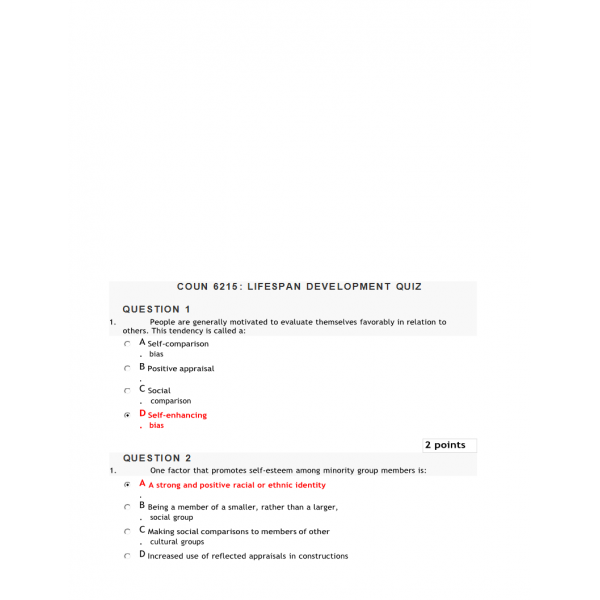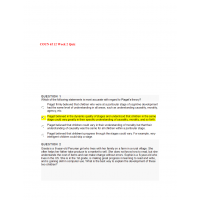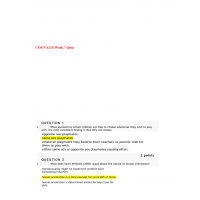COUN 6215 Week 2 Quiz (V2)
COUN 6215 Week 2 Quiz
1. People are generally motivated to evaluate themselves favorably in relation to others. This tendency is called a:
2. One factor that promotes self-esteem among minority group members is:
3. Individuals with low levels of self-esteem would be more likely than those with high self-esteem to:
4. As Selena and her friends are walking home after school they approach a corner store and see bags of candy and snacks on open shelves outside the front door. A young clerk is
5. As Selena and her friends are walking home after school they approach a corner store and see bags of candy and snacks on open shelves outside the front door. A young clerk is also outside waiting for customers. As they get closer, they see the clerk go inside the store. Selena’s friends encourage her to take a bag of candy, but she refuses. How would an
individual in Kohlberg’s conventional stage of moral reasoning explain Selena’s behavior?
6. Which of the following is a temperamental characteristic that is associated with prosocial behavior?
7. It is generally a best practice for counselors to approach working with youngsters who demonstrate anger, noncompliance, and aggression in which of the following ways?
8. Levels of social cognitive do not always match .
9. Tiffany is 3 years old. She knows that she is a girl, and she expects to be a girl tomorrow, but she does not understand that her gender is permanent. She believes that cutting her hair short could change her gender. Tiffany has but not .
10. In adolescence and early adulthood, males and females begin to spend more time in mixed-gender groups. Studies of who has more influence on the outcome of problem solving in mixed-gender groups indicate that:
11. Social skills training programs are interventions in which children are taught specific, discrete behaviors that can facilitate effective social interactions, like making eye contact and asking appropriate questions. Assessments of these interventions indicate that they have modest success in improving peer acceptance. Which of these is the best description of a major shortcoming of these intervention programs?
12. One gender-related characteristic of peer evaluations is that:
13. In middle childhood and early adolescence, cliques serve the purpose of:
14. Counselors working with young children should know that children as young as usually show some knowledge of gender-related preferences and activities.
15. Counselors working with school-age children and adolescents need to recognize that gender identity continues to develop in these years. Among the important findings from recent research is that girls tend to feel:
16. Which of the following is a well-documented gender difference in brain structure?
17. Allie’s 8th grade academic work is a little more advanced than what she is used to. She is having a hard time keeping up, particularly in science, which is her first period course. The teacher moves very fast, despite the fact that most of the students look glassy-eyed from too little sleep. What is a puberty-related biological explanation for the students’ behavior in science class?
18. A coping style which has been linked to higher levels of depression among adolescent girls and women is:
19. Studies show that formal operational thinking is:
21. Which of the following most accurately reflects Erikson’s view of identity?
22. Colin is applying for the pre-med major. Colin worked in the health science area for several years before returning to college. He is very serious about doing well in school. According to Marcia’s categories of identity status, which placement would you assign to
Colin with regard to his vocational identity?
23. When counseling adolescents who are unsure of their sexual identity, helpers should keep in mind that:
24. Which of the following is true of American teenagers’ knowledge of HIV/AIDS?
25. Steinberg and Scott (2003) argue that, when teenagers are found guilty of a crime, it may be that their culpability is mitigated in comparison to that of typical adults. Which of these is NOT one of the reasons they argue teenagers are probably less culpable than adults?
| Institution & Term/Date | |
| Term/Date | Walden University |
-
$9.99











